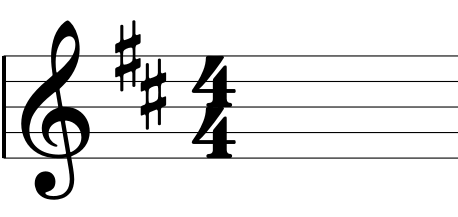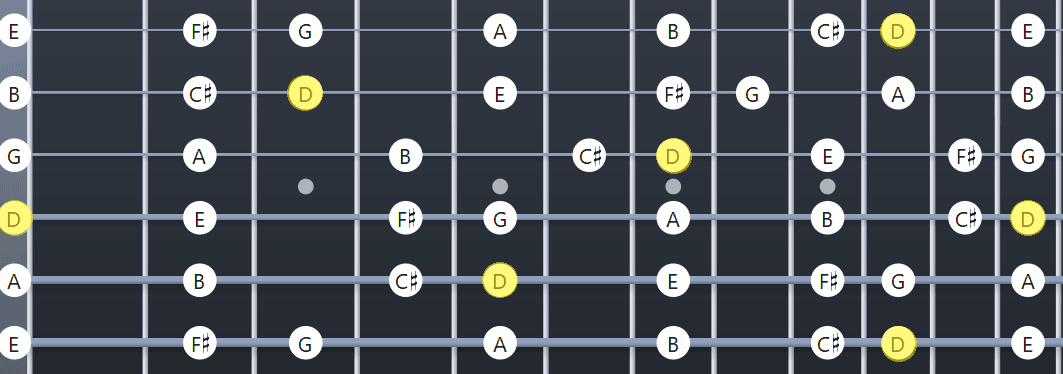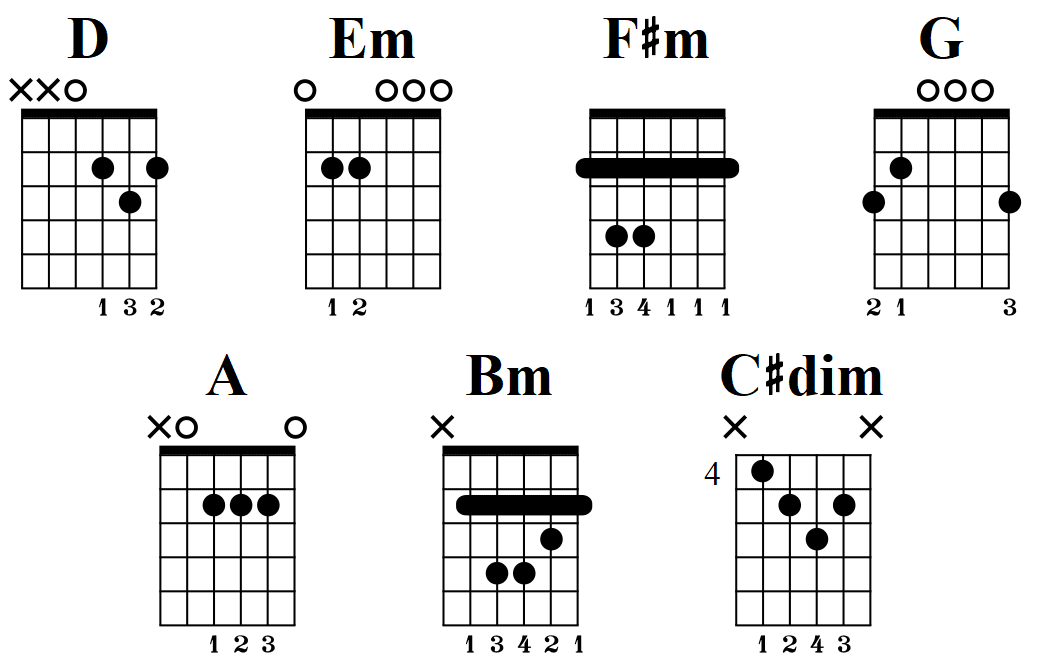The D Major Scale is one of the most common scales you should learn on the guitar. After you learn the C Major Scale (learn the C Major scale in this guide) I recommend learning the G Major scale, then learn the D Major scale.
This guide covers everything you might want to know about the D Major scale including common open chords, note positions on a fretboard diagram, and more.
These resources are based on having your guitar in standard tuning. Read this guide on Alternate Guitar Tunings if you want to try something different.
Note: the resources here are helpful, but they should only be a starting point for your practice. Once you memorize these notes on your fretboard, you won’t need to use the resources found in this guide. Find out how to memorize the notes on the fretboard here using effective methods that don’t require much time or effort.
D Major Scale = B Minor Scale
For every Major scale in music, there is what we call a ‘relative’ minor. A ‘relative’ scale is one that uses the same notes but is used in different ways. This means for every Major scale, there is a minor scale using the same notes.
The D Major scale and the B minor scale both use the exact same notes. The main difference between the two (to keep things simple) is the root note of each scale. In the D Major scale, the root note is ‘D’. In the B minor scale, the root note is ‘B’.
Once you learn some basic music theory you will understand how two different scales can use the same notes, but for now, all you need to do is remember that both D Major and B minor scales use the same notes.
This means you can use all the diagrams, exercises, and chords covered in this guide for both the D Major scale and the B minor scale.
Notes in the D Major Scale
The D Major scale is easy to remember because it only contains two sharp notes. The notes in the D Major Scale are: D E F# G A B C#
This is what the key signature for D Major looks like:

Even if you don’t know how to read music, if you see a key signature with two sharp symbols, it means the music is in D Major (or B minor).
The notes in the B minor scale are: B C# D E F# G A. As you can see, it’s the exact same notes as the D Major scale. The B minor scale starts on ‘B’ (called the root note) and the D Major scale starts on ‘D’, but both scales contain the same seven notes.
The main notes to keep in mind when memorizing the D Major scale is C# (C sharp) and F# (F sharp). You only need to remember that the D Major scale uses C# and F# and all the other notes are natural (not sharp or flat).
This is why I suggest learning the D Major scale after you learn the G Major scale (learn the G Major scale in this guide). The G Major scale is easy to learn because it only uses one sharp note: F#. Once you memorize that, all you need to do to change from G Major to D Major is remember to add in one more sharp note: C#.
After you feel confident with the D Major scale, I suggest learning the A Major scale.
Circle of Fifths
You may have heard about the circle of fifths. The circle of fifths makes use of patterns to help you move from one scale to the next.
If you know the basics of intervals (learn about intervals in this lesson), you’ll start to see the patterns as we move from C Major to G Major to D Major.
If we start from the C and move up a fifth, we end up on G. If we move up a fifth from G, we end up on D.
That’s the same order I suggest memorizing scales. Start with learning the C Major scale (no sharps or flats), then learn the G Major scale (one sharp), then the D Major scale (two sharps).
Notice the jump in fifths between each scale root note? If you can, you can probably already figure out what the next scale in the series might be (hint: what’s a fifth up from D?).
You’ll also notice that we add one more sharp note to the scale each time.
Hopefully, this short description gives you a glimpse of how useful music theory can be. With some basic music theory, you can easily memorize the notes in all scales without having to look anything up.
To learn more about this basic theory, read this lesson on intervals.
D Major Scale Fretboard Diagram
Here are the notes of the D Major scale across the entire fretboard:

The main notes to focus on when you try to memorize this scale are D, C# and F#.
You want to pay extra attention to D because it’s the root note, so you want to be able to easily find those note positions while improvising or writing riffs.
You also want to pay attention to the C# and F# positions to help you switch into this scale from C Major or G Major.
Here is the D Major scale diagram up to the 12th fret with the root notes highlighted on each string:

Read my lesson on how to memorize the fretboard to get the most out of this diagram.
How to use the above fretboard diagram:
- Improvise over a D Major or B minor backing track by playing any of the above notes
- Learn to find chord shapes that fit with the highlighted notes
- Practice scale runs between any two points on the fretboard (don’t just stick to scale shapes you’ve already memorized)
- Memorize the notes on the fretboard one string at a time
If you’ve already spent time memorizing the C Major or G Major scale, you might be surprised by how quickly you can fully memorize the D Major scale.
The more scales you learn using the method covered in the above guide, the faster it is to learn any new scales.
D Major Scale in Guitar TAB and Standard Notation
The below Guitar TAB and standard notation show three examples of the D Major scale starting on different root note positions:

If you don’t know how to read the above example, find out how to read Standard Notation in this guide and how to read Guitar TAB in this guide. Knowing at least one of these methods can significantly speed up your progress.
Try playing the examples to get a feel for how D Major sounds and where the correct notes are on the fretboard.
I recommend trying to avoid playing scale runs like this as your main form of practicing scales. Playing up and down scale shapes can lead to bad habits and a lot of guitarists eventually get stuck in a rut.
This lesson talks about how to practice guitar scales in an effective way.
D Major Scale Open Chords on Guitar
One of the reasons why the D Major scale is such a popular scale for guitarists is because many of the basic open chord shapes you probably already know fit with the scale.
Here are the seven main chords of the D Major scale:

You might already know most of these chords as they are some of the most common open chords on the guitar.
F#m and Bm are played easiest as barre chords, so if you’re not comfortable with barre chords yet, focus on learning the C Major and G Major scales first.
Try making up some chord progressions using the above chords and listen to how they sound when played together. A lot of songs use the above chords so you may find you accidentally play a progression from a well-known song.
Don’t worry about the last chord (C#dim) as you’re unlikely to use it. When we harmonize a Major scale, the last chord in the scale is always a diminished chord. While diminished chords are used in music, as a beginner or intermediate guitarist you may not have much use for them yet.
Note: remember that the B minor scale uses the exact same notes as the D Major scale. This means the above chords also fit in the key of B minor.
As mentioned earlier, you shouldn’t rely on these resources. Learn how to memorize the notes on the fretboard. It might be easier to use a chart like the ones above to find your way across the fretboard, but you’ll become a far better guitarist if you properly memorize the fretboard notes.
Guitar Songs Using the D Major Scale
There are countless songs written on guitar using the D Major scale. The scale makes use of all of the open strings and there are a lot of open chords that fit perfectly with the scale.
Here are some popular guitar songs using the D Major scale:
- Hotel California by The Eagles
- Comfortably Numb by Pink Floyd
- With or Without You by U2
- The Thrill is Gone by B.B. King
- Wake Me Up by Avicii
- Everlong by Foo Fighters
- Thinking Out Loud by Ed Sheeran
- Summer of ’69 by Bryan Adams
- Back in Black by AC DC
- Lithium by Nirvana
Keep in mind that the D Major and B minor scales use the same notes, so some of the above songs are in the key of D, while others are in the key of B minor.
Here are some other resources for guitar scales worth learning:
For more resources, check out these guides. You can get notifications on new resources, guides, lessons, and reviews by subscribing to email updates here.
